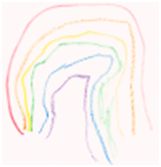 A whimsical picture of smiling children and a caption – Image Credit: Mackenzie Moreland, age 4 – under a Picasso-esque drawing on Ken Moreland’s Sandia National Laboratories website suggests he is hardly all work, no play, and no personal life.
A whimsical picture of smiling children and a caption – Image Credit: Mackenzie Moreland, age 4 – under a Picasso-esque drawing on Ken Moreland’s Sandia National Laboratories website suggests he is hardly all work, no play, and no personal life.
On the contrary, this husband and father says he’s learned the need to separate work and family. From avoiding “the constant barrage of e-mail” to putting his latest research problem out of his mind, Moreland says that “a simple change in priorities and attitude makes a huge difference in play time with the kids and can be helpful in keeping a fresh, innovative perspective.”
Among his peers in the field of visualization research, Moreland is known as both an innovative thinker and excellent communicator, a rare double threat in a science dominated by numerical complexity and techno-jargon that can be hard to grasp.
“I find it difficult to imagine scientific advancement without good communication, which is particularly important in visualization,” says Moreland, who leads tutorials and participates in conferences, workshops and other community outreach efforts at the Institute for Ultra-Scale Visualization. “The benefit of our science is defined through understanding in other domains. A visualization must be accessible to non-experts or it provides little value.”
At home, Moreland practices what he preaches, encouraging his children to “dig deeper” in pursuit of that more interesting something. “I try to point out the science behind everyday things such as why a utility tower’s struts form a framework of triangles, why condensation forms on a glass of ice water, or even how a toilet works.”
The evidence suggests Moreland’s family tutorials are bearing fruit. His daughter already is engaged in the art of imagery, mere steps from the science of visualization amidst a world of contemporary programs encouraging girls to tackle scientific disciplines. Though inspiring initiatives are a good thing, Moreland says he prefers a “gender agnostic” approach that emphasizes communication, from the schoolroom to the science fair.
“The foundation of science is repeatable experimentation, and the refinement of theories based on new observations,” Moreland says. “Communication is the key to sharing theories, verifying work and cross-pollinating ideas.”